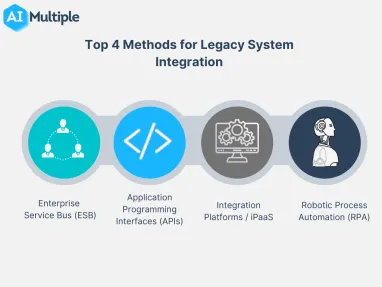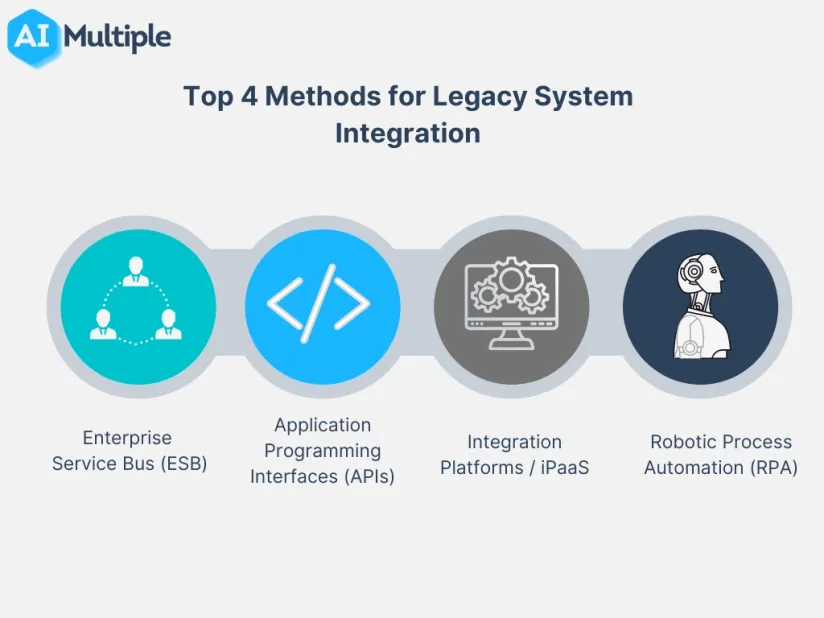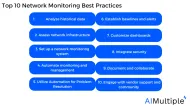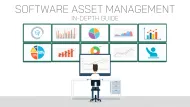Legacy System Integration in 2024: Top 4 Use Cases


Even with accelerated digital transformation and hyperautomation efforts within the enterprise, many industries still rely on outdated technologies that are prone to security issues and lack the expertise to work with:
- Retailers spend nearly 60% of their IT budget on maintaining legacy systems,
- Legacy systems are the norm in the healthcare industry as 80% of healthcare organizations use legacy systems such as Windows Server 2003,
- US government agencies use legacy systems that are up to 50 years old. The Operating and maintenance cost of these systems is over $300 million annually.
These systems are still pervasive because replacing them is not straightforward, and errors can lead to costly disruptions. On the other hand, they need to be able to work with modern software such as cloud applications. In this article, we’ll explore four ways to integrate legacy systems with other applications, with their advantages and disadvantages:
- Enterprise service bus (ESB)
- Application programming interfaces (APIs)
- Integration platforms or iPaaS
- Robotic process automation (RPA)
An enterprise service bus (ESB) is a core component of service-oriented architecture (SOA). SOA is a software architecture that emerged in the late 90s to replace the unified and self-contained monolithic software architecture. SOA consists of different software components that serve to execute a discrete business function. An ESB is a middleware that integrates various software components and enables them to communicate and exchange data with each other within SOA.
As such, an ESB is the traditional approach to integrating different types of software within an organization. Pros of using ESB for legacy integration are:
- It enables integrating multiple applications into a single ecosystem.
- It standardizes communication between applications across the company.
However, with the advent of microservices architecture in the 2010s, ESBs are being replaced by more decentralized integration methods. Cons of using ESB for legacy system integration are:
- It is a centralized component that is susceptible to becoming a single point of failure. In case of a slowdown or crash, all systems across the enterprise will be affected.
- Most ESBs are designed for internal systems as an on-premises solution. This makes integrating legacy systems with third-party cloud apps impossible.
2. Application programming interfaces (APIs)
APIs are currently one of the most common ways to connect different technologies, including legacy systems. According to a global annual survey by RapidAPI, nearly 80% of developers say participating in the API economy is a top priority for their organizations or will be soon.
APIs are a set of defined rules and protocols on how different software would communicate with each other. In this way, they serve a similar purpose as an ESB. However, in contrast to an ESB, APIs provide the following advantages:
- They are compatible with most modern applications. This means you can integrate your legacy system both with internal tools and third-party apps.
- They enable integration with cloud applications. This is an important feature as an average enterprise uses 1200 cloud applications.
- They help businesses share their data with customers or third parties and monetize their data.
On the other hand, most legacy applications don’t support API connectivity. This means companies should:
- Hire developers that are experts in API development and in the technology that legacy system uses,
- Develop their custom APIs for legacy integration,
- Refactor their legacy systems for API support.
So, the challenge for legacy integration with APIs is that it can be costly and time-consuming.
3. Integration platforms or iPaaS
The third option is to use an integration platform or an iPaaS. An integration platform is composed of tools, such as connectors, adaptors, APIs, etc., that allow data, applications, systems, and business process integration. In other words, the platform provides you with the tools you would otherwise need to develop.
Therefore, integration platforms and iPaaS have the following advantages:
- They allow businesses to build integrations without months of coding.
- They allow both on-premises and cloud integration.
- You don’t need to maintain the integrations as the vendor does it for you.
However, using a third-party platform for legacy integration can have some drawbacks:
- The platform may lack the specific connectors, APIs, etc. that you need for integration.
- Choosing the wrong vendor may end up in a vendor lock-in situation.
- Engaging with third-party tools carries a security risk.
Check our article on iPaaS for a more comprehensive account.
4. Robotic process automation (RPA)
Leveraging robotic process automation (RPA) and intelligent automation solutions with AI capabilities is another option for integrating legacy systems with modern software. AI-driven RPA bots can:
- Connect to different types of software,
- Read computer screens as humans do with an understanding of the context, using NLP and computer vision,
- Extract and migrate data between different applications.
The advantages of using RPA and intelligent automation for legacy integration are:
- It does not require developing custom solutions for connectivity or purchasing integration platforms.
- Bots can work independently of the technology used in legacy and modern apps, both in front-office and in back-office.
- Bots are easy to create and don’t require development expertise.
On the other hand, using RPA for integration can have some limitations:
- You need to test whether the bots work correctly and monitor their behavior. This means it requires constant maintenance.
- APIs and integration platforms can scale better than RPA for high-volume transactions.
Since each method has its advantages and disadvantages, businesses should evaluate their short- and medium-term needs and combine different methods as necessary.
In the long term, however, legacy systems can become an obstacle in the way to digital transformation. If you’d like to learn how to upgrade your legacy systems, read our article on application modernization.
If you have other questions, feel free to ask:

Cem has been the principal analyst at AIMultiple since 2017. AIMultiple informs hundreds of thousands of businesses (as per similarWeb) including 60% of Fortune 500 every month.
Cem's work has been cited by leading global publications including Business Insider, Forbes, Washington Post, global firms like Deloitte, HPE, NGOs like World Economic Forum and supranational organizations like European Commission. You can see more reputable companies and media that referenced AIMultiple.
Throughout his career, Cem served as a tech consultant, tech buyer and tech entrepreneur. He advised businesses on their enterprise software, automation, cloud, AI / ML and other technology related decisions at McKinsey & Company and Altman Solon for more than a decade. He also published a McKinsey report on digitalization.
He led technology strategy and procurement of a telco while reporting to the CEO. He has also led commercial growth of deep tech company Hypatos that reached a 7 digit annual recurring revenue and a 9 digit valuation from 0 within 2 years. Cem's work in Hypatos was covered by leading technology publications like TechCrunch and Business Insider.
Cem regularly speaks at international technology conferences. He graduated from Bogazici University as a computer engineer and holds an MBA from Columbia Business School.
To stay up-to-date on B2B tech & accelerate your enterprise:
Follow on

Comments
Your email address will not be published. All fields are required.